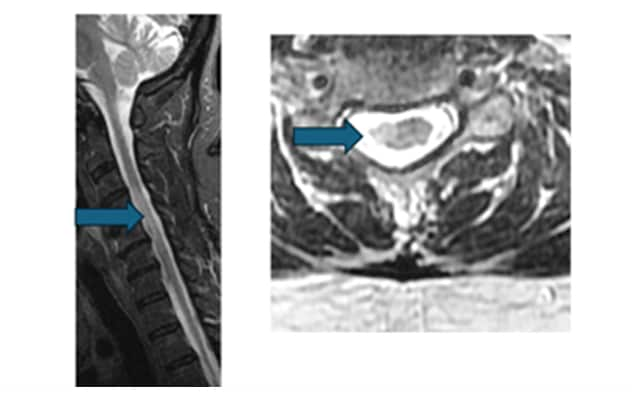May 30, 2025
Studies of the development of progressive multiple sclerosis (MS) have focused mostly on brain parenchymal changes. Mayo Clinic physician-scientists are investigating the role of what they call "critical" demyelinating spinal cord lesions.
"We have found a compelling association between prominent spinal cord lesions and MS progression," says B. Mark Keegan, M.D., a neurologist at Mayo Clinic in Rochester, Minnesota. "These critical lesions are typically located in the spinal cord lateral columns, are focally atrophic and anatomically associated with motor progression."
Mayo Clinic's work on critical lesions began with examinations of cases involving patients with progressive solitary sclerosis. "They had no other lesions, so the association with their progressive weakness was very clear," Dr. Keegan says. The researchers have since evaluated individuals with multiple lesions whose motor progression is anatomically attributable to single demyelinating lesions in the corticospinal tract.
 Lesión medular desmielinizante crítica
Lesión medular desmielinizante crítica
Las resonancias magnéticas muestran una gran lesión de la médula espinal cervical lateral derecha C4-C5 con atrofia localizada (flechas) característica de una lesión desmielinizante crítica. La paciente acudió a Mayo Clinic después de presentar una debilidad lentamente progresiva en su pierna y brazo derechos durante 12 años. Le diagnosticaron esclerosis múltiple progresiva primaria y comenzó el tratamiento con ocrelizumab.
In a study published in Multiple Sclerosis, the researchers found that the presence of critical spinal lesions was the main factor independently associated with motor progression in individuals with longstanding MS. "This was the case despite similar disease duration and number of clinical relapses," Dr. Keegan says.
Impact on patient care
The work on critical spinal lesions has changed how Mayo Clinic neurologists approach patient care. "We recognize the importance of spinal cord imaging on a routine basis for people with MS," Dr. Keegan says. "We engage with our neuroradiology experts to review MRI of the spinal cord with a very high level of technical expertise and top-line imaging. We recognize the importance of evaluating people with MS carefully and conscientiously, taking time to understand their problems."
MR features of critical lesions were described by Mayo Clinic researchers in the American Journal of Neuroradiology.
Awareness of critical lesions facilitates accurate diagnosis. Dr. Keegan cites a patient who came to Mayo Clinic after years of treatment at a tertiary center. The patient had received a diagnosis of neuromuscular disorder and undergone electromyography and genetic studies as well as muscle biopsy.
"Our workup found a critical demyelinating lesion in the patient's spinal cord," Dr. Keegan says. "That lesion was clearly responsible for the patient's progressive motor weakness. He didn't know he had MS."
Identifying critical lesions also facilitates prognosis for individuals who already have a diagnosis of MS. "We can counsel patients on why they might or might not have progressive disease," Dr. Keegan says. "We couldn't provide that in the past."
Future research aims to understand how critical spinal lesions develop. One particular focus is what Dr. Keegan calls "high risk" lesions: prominent demyelinating spinal lesions that later may develop into critical lesions.
"Some people have a clinical attack that causes impairment on one side, but then they recover — sometimes completely," Dr. Keegan says. "Then, many years later, we see a critical demyelinating lesion in the exact same site that is now causing progressive impairment. Is something happening within that lesion that can resolve initially and then progressively worsen later? We're very interested in determining whether people with and without these high-risk lesions are likely to develop progressive MS."
That knowledge ultimately might guide the development of new therapies. "If we could somehow prevent the development of critical lesions, we might help prevent MS progression," Dr. Keegan says.
Understanding the neuropathology of critical spinal lesions is challenging. Spinal biopsies are seldom performed due to potential patient harm. Postmortem analysis of MS lesions also is rare. "Finding patients who consent to postmortem examination is important for finding out what is happening in those lesions," Dr. Keegan says.
The work on little-studied aspects of MS exemplifies Mayo Clinic's commitment to advancing patient care. "We have a tradition in the Division of Multiple Sclerosis and Autoimmune Neurology of being pioneers in developing novel ways of thinking that often challenge existing beliefs," Dr. Keegan says. "That allows us to be leaders in explaining disease processes and therapies and advancing care."
For more information
Sechi E, et al. Critical spinal cord lesions associate with secondary progressive motor impairment in long-standing MS: A population-based case control study. Multiple Sclerosis Journal. 2021;27:667.
Keegan BM, et al. MR imaging features of critical spinal demyelinating lesions associated with progressive motor impairment. American Journal of Neuroradiology. 2024;43:943.
Multiple Sclerosis and Autoimmune Neurology. Mayo Clinic.
Refer a patient to Mayo Clinic.